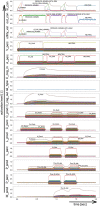Hierarchical Sequencing and Feedforward and Feedback Control Mechanisms in Speech Production: A Preliminary Approach for Modeling Normal and Disordered Speech
- PMID: 33262697
- PMCID: PMC7686541
- DOI: 10.3389/fncom.2020.573554
Hierarchical Sequencing and Feedforward and Feedback Control Mechanisms in Speech Production: A Preliminary Approach for Modeling Normal and Disordered Speech
Abstract
Our understanding of the neurofunctional mechanisms of speech production and their pathologies is still incomplete. In this paper, a comprehensive model of speech production based on the Neural Engineering Framework (NEF) is presented. This model is able to activate sensorimotor plans based on cognitive-functional processes (i.e., generation of the intention of an utterance, selection of words and syntactic frames, generation of the phonological form and motor plan; feedforward mechanism). Since the generation of different states of the utterance are tied to different levels in the speech production hierarchy, it is shown that different forms of speech errors as well as speech disorders can arise at different levels in the production hierarchy or are linked to different levels and different modules in the speech production model. In addition, the influence of the inner feedback mechanisms on normal as well as on disordered speech is examined in terms of the model. The model uses a small number of core concepts provided by the NEF, and we show that these are sufficient to create this neurobiologically detailed model of the complex process of speech production in a manner that is, we believe, clear, efficient, and understandable.
Keywords: aphasia; computer simulation; hierarchical sequencing; neural engineering framework (NEF); neurocomputational model; semantic pointer architecture (SPA); speech disorders; speech processing.
Copyright © 2020 Kröger, Stille, Blouw, Bekolay and Stewart.
Figures












References
-
- Cholin J. (2008). The mental syllabary in speech production: an integration of different approaches and domains. Aphasiology 22, 1127–1141. 10.1080/02687030701820352 - DOI
-
- Eliasmith C. (2013). How to Build a Brain: A Neural Architecture for Biological Cognition. New York, NY: Oxford University Press.
-
- Eliasmith C., Anderson C. (2004). Neural Engineering: Computation, Representation, and Dynamics in Neurobiological Systems. Cambridge, MA: MIT Press.
-
- Glück C. W. (2011). WWT 6-10. Wortschatz-und Wortfindungstest Für 6-Bis 10-Jährige. München: Urban and Fischer.
LinkOut - more resources
Full Text Sources

